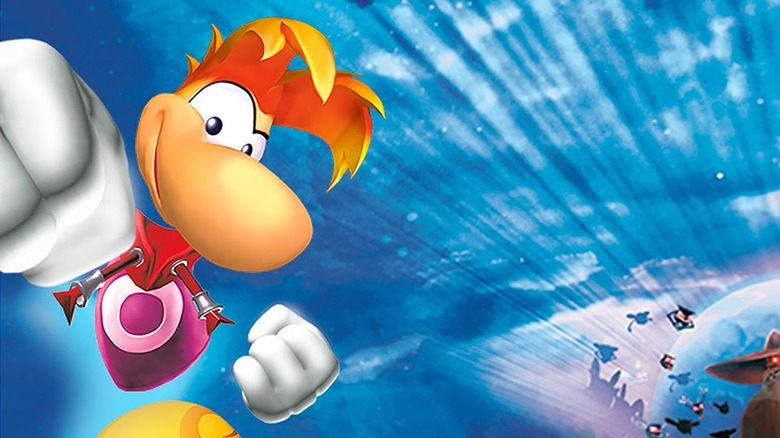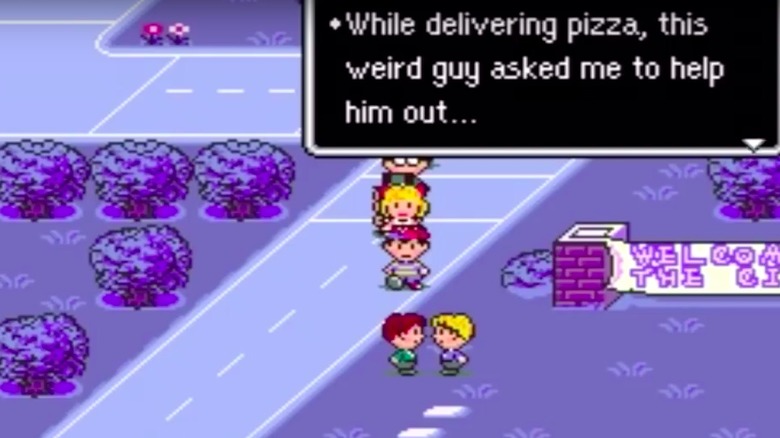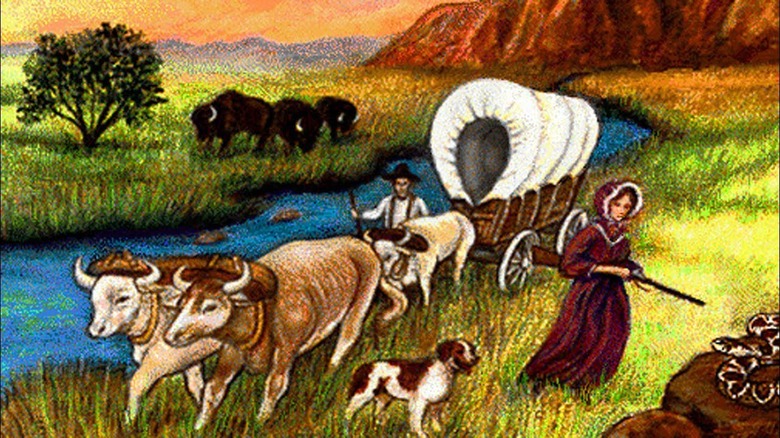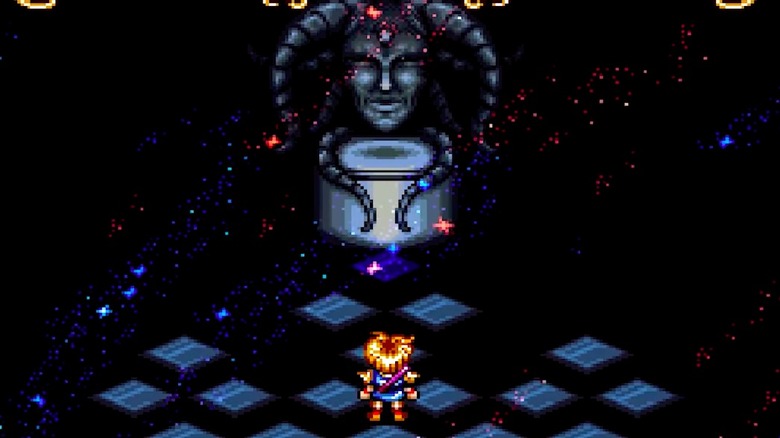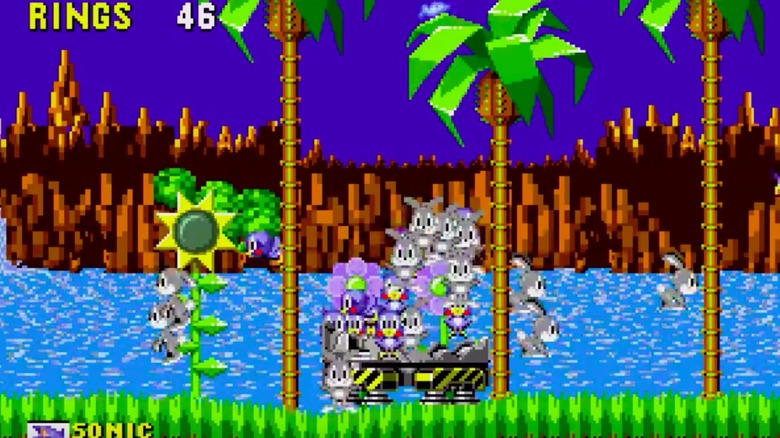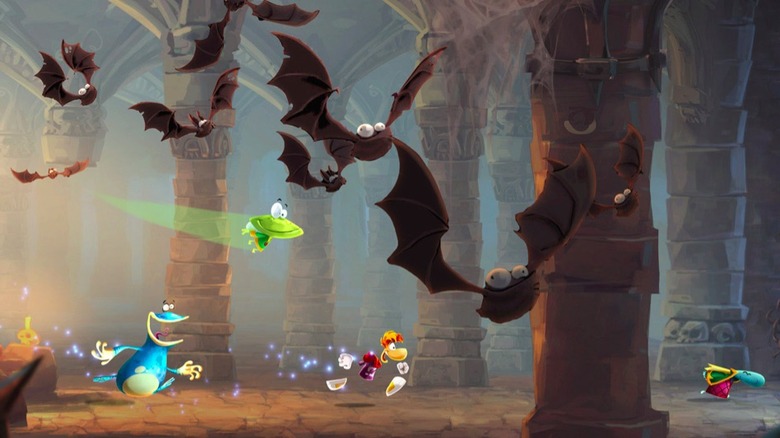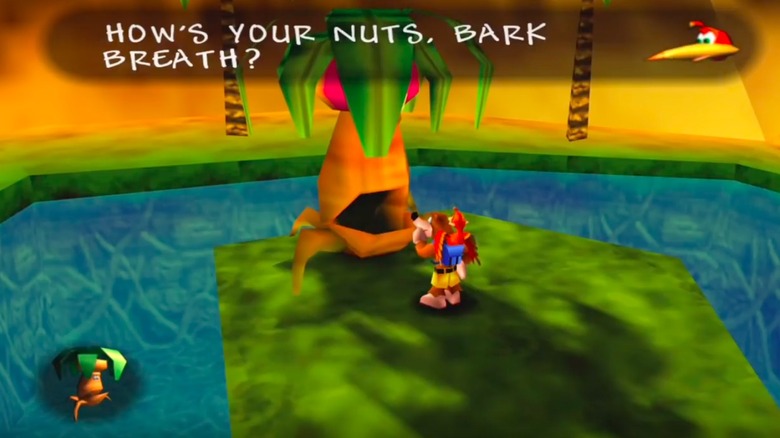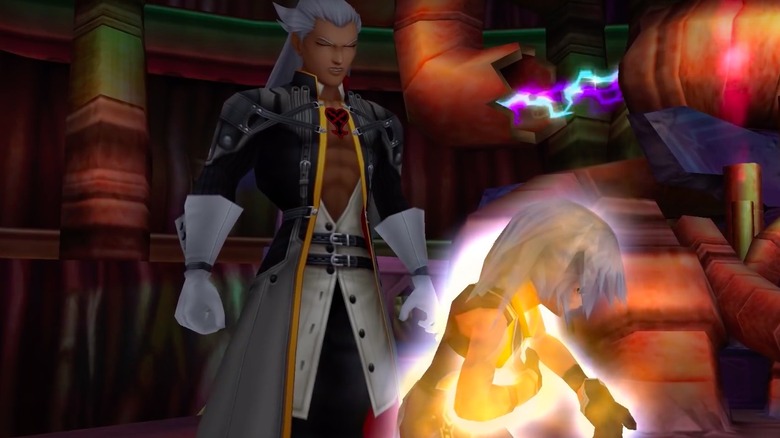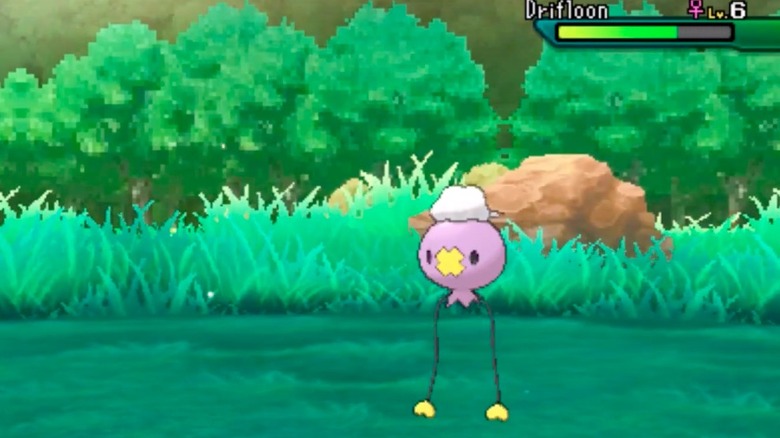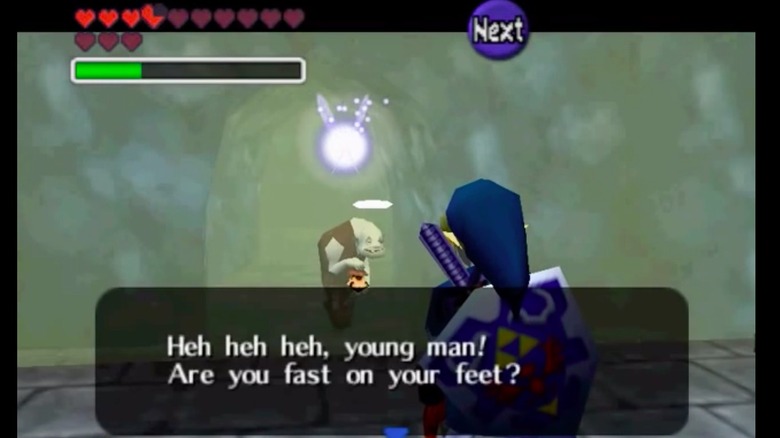Games You Played As A Kid That Are Really Inappropriate
Gaming today is something entirely different than it was for kids who grew up in the '80s and '90s. While many games now have graphic violence and explicit language, most games from a decade or two ago were aimed specifically at young gamers. But this doesn't necessarily mean that developers left adult content out of their stories completely. Like kids' movies that want to include some humor for the adults who have been dragged to the theater, a lot of games include things that aren't quite appropriate for their young target audience.
Most of the "inappropriate" things found in these games are so well hidden that most gamers didn't notice them until much much later in life. Often, these things are not only subtle, but are simply implied, sometimes being so buried that fans of the games have had to uncover their true meanings themselves. With everything from possession to dying from dysentery, here are a few games made for children that, in retrospect, are actually pretty inappropriate.
Adults, police officers, and cultists alike beat up a child in Earthbound
Released in 1994, Earthbound was a very different type of game than what players were used to on the Super Nintendo. The turn-based fighting style was simplistic and the game itself thrived on the weird and abnormal. For those '90s kids lucky enough to own the game, they might have remembered getting scratch and sniff cards with their purchase. But unfortunately, these scratch and sniff cards were things like farts and vomit. Not exactly an appealing prospect.
One of the many things that set Earthbound apart, however, is the fact that the game had many dark and morbid aspects that often went right over the younger audience's heads. Not only are the children in the game much more moral and ethical than the adults, but the adult NPCs are violent towards our young child protagonists. From corrupt police officers who bring a child into a room and fight him five-to-one, to an actual cult in the Happy Happy Village who have questionable motives, this game had a lot more going on than the pleasant music and psychedelic zones would suggest.
Convincing children for generations that they may randomly die from dysentery
There are a few things that were drilled into your mind so frequently in childhood that you were convinced they would be a bigger part of your adult years; from having to handwrite long division to getting under your desk for an earthquake drill. But one of the fears that plagued many children, thanks to video games, was the notion that you were extremely likely to randomly die from dysentery at some point in your life. This is largely thanks to time spent in the computer lab playing the infamous Oregon Trail.
This 8-bit game developed by the Minnesota Educational Computing Consortium was meant to teach children about the hardships of 19th-Century living. In it, gamers were able to manage resources, plan their trip across the plains, and attempt to determine which profession would suit their family best on their long trek. Unfortunately, the Minnesota Educational Computing Consortium decided to make this particular game a bit too educational when they included various ways to die, including starvation, a snake bite, or cholera. But the one horrific fatal encounter that seemed to stick with children for years to come was dysentery. This illness killed off countless virtual families so often, that many young impressionable gamers probably believed that dysentery was an ever-present threat, lurking around every corner. Spoiler alert: it isn't.
Nothing says childhood trauma like watching a pet pig burn itself alive to save you
Quintet's 1993 RPG, Illusion of Gaia, took an ambitious approach to the genre when it was released. Following the player character Will in his journey to collect the six statues needed to save earth from an impending cosmic destruction, the game actually takes players to real locations that can be found in our world. But Illusion of Gaia had a few other things going for it, some of which resulted in childhood trauma that you weren't expecting from an otherwise family-friendly game.
Though Illusion of Gaia was a bit more serious and narratively advanced than other games in its genre, it was still, first and foremost, a game made for children. But at one point in the game, when the characters visited Ankor Wat, things took a dark turn. Meeting up with several villagers, Will and his friends find that the people of Ankor Wat are starving. Because of this, they require that Will and his friends become human sacrifices to feed the people of the village. If this idea wasn't traumatizing enough for young minds, the confrontation is eventually settled when Hamlet, your friend Kara's pet pig, walks into the native's fire, burning himself alive to save you and your friends. This unexpected sacrifice left many a child scarred and asking themselves why Will and his friends couldn't have just done a side quest to get the villagers some food.
Sonic the Hedgehog introduced kids to animal cruelty
When discussing the Sega Genesis, one title is synonymous with the smooth black console: Sonic the Hedgehog. Though the Genesis did have other entertaining titles, none seemed to stand the test of time quite like Sonic did. He became something of a mascot for the company and is still such a fan favorite that new games keep coming out. The speedy blue hedgehog seems to make a resurgence every few years.
But in looking back at this nostalgic children's game from 1991, a few things stick out that you may not have noticed on your first playthroughs as a youngster. The main antagonist, Dr. Ivo Robotnik (aka Dr. Eggman), is a mad scientist set on creating his idea of the perfect world. Unfortunately for everyone else, his perfect world means capturing all of the animals he can find and turning them into robots. Since the main protagonist and playable character is, in fact, an animal, this idea proves to be a bit dark. Add to that the fact that when Sonic does manage to defeat Robotnik, he releases the adorable 2D animals from a metal prison where they had been squished together, and you've got yourself some troubling imagery. Apparently animal cruelty seemed like a good way to make people hate your main bad guy. Mission accomplished.
The Knaaren in Rayman 3 are terrifying
Like many of the other titles on this list, Rayman is a game that did things a bit differently, rather than conforming to the ever-changing trends in the gaming world. Just as 3D games were becoming more popular and mainstream, Rayman was released as an unapologetically 2D puzzle platformer. And while there were a few things that could be a bit too mature for children in the first two games of this franchise, the thing that sticks out the most happens in Rayman 3: Hoodlum Havoc.
In the third installment of the Rayman games, our protagonist finds himself in the Desert of the Knaaren. The creatures who inhabit this region seem to be a bit much for a kid's game for a few reasons. The things the Knaaren say to Rayman as he tries to escape them start out comical enough, shouting out threats like, "Make him write bad checks." But it's the less humorous threats that seem to be out of place in a family-friendly story. As you attempt to escape, they can be heard saying, "Stick bamboo under his nails," "Tear off his flesh," and the still-disturbing-to-this-day "Let him run. Meat better with salt."
These terrifying threats seem out of left field in an otherwise innocuous game, and it's not likely that the threats went over young gamers' heads. These game developers have some explaining to do to a generation of traumatized youth.
Banjo-Kazooie is littered with double entendres
Banjo-Kazooie is a classic example of everything right about the Nintendo 64. This game managed to solidify its place in the ranks of great Nintendo games in a Mario-dominated world. It's even spawned a spiritual successor, Yooka-Layley, to satisfy the diehard fans of the franchise who needed more Banjo in their lives. But underneath the colorful scenery and talking puzzle pieces, it's difficult to forget that the game developer who created the beloved Banjo-Kazooie, Rare, is known for sneaking not-quite-kid-friendly material into their games.
Playing Banjo-Kazooie as a kid, most of the hidden Rare jokes would be totally unnoticed. But playing through the game again as an adult, it's easy to see that the game is littered with double entendres. With everything from phallic-shaped characters, to inappropriate innuendos from Kazooie in at least half of your interactions with NPCs, to the very questionable drink names in Jolly's Bar, it's amazing the game made it past censors with an E rating. Even if the jokes were too adult for kids to understand, you may still be shocked when you go back for a replay at just how much Rare got away with.
In Kingdom Hearts, a grown man takes possession of a teenager's body to kill people
Nothing says childhood and innocence like Disney. The entire empire is built around magic and the wonder of staying young at heart. Because of this, the melting pot of Disney characters found in the Kingdom Hearts franchise are all family-friendly. While things can get a bit scary in the Kingdom Hearts games, the overall consensus is that developer Square Enix managed to keep things mild enough for children to play, while still creating complex narratives.
When you really stop to think about some of the things that happen in Kingdom Hearts, however, you may begin to see that a few things aren't as innocent as they seem. For example, everything that transpires at Hollow Bastion is much darker than it may appear on the surface. Not only does Ansem, the antagonist who also happens to be an adult man, possess the body of Riku, a young teenage boy, but he also attempts to use Riku to kill not only Sora, but also Kairi. It's also implied that this isn't the first time Ansem has possessed Riku in order to carry out his sinister deeds. The idea of a grown man using a teenage boy to murder others seems a bit out of character for Disney. But then again, it is the same company who brought you Old Yeller, so maybe dark undertones aren't totally outside their wheelhouse.
Pokemon is full of dark backstories
With a franchise as diverse, expansive, and long-lived as Pokemon, it would almost be impossible to keep things completely kid-friendly at all times. It would be totally understandable for this beloved franchise to have a few slip-ups here and there, since the game is about people capturing monsters and battling each other. But the inappropriate elements found in this franchise don't come from off-color jokes or hidden Easter eggs. Instead, the semi-traumatizing aspects of Pokemon come from the deliberately terrifying backstories of many of the Pokemon available in the various games.
The list of Pokemon with horrifying backstories could go on for days, which is a bit strange when one considers the target audience of this franchise. But somehow, lethal and soul-stealing Pokemon made it past the ESRB. A few standouts are particularly notable for their ability to traumatize children and adults alike. Drifloon, for example, is a ballon-ish creature who takes children by the hand and floats them away to the other side. There's also Mimikyu who is equal parts scary and tragic. A Pokemon so terrifying the mere sight of it can cause illness or death, Mimikyu wears a costume that looks like a poorly-drawn Pikachu in order to try to make people love it. While its appearance is something straight from a nightmare, its backstory is tragic, making it doubly questionable for a child's game.
Dampe the gravekeeper offers to dig up graves with Link
Of all of the video game characters in existence, Link is easily one of the most iconic and recognizable. The Legend of Zelda franchise has spawned dozens of games and is still going strong to this day. While the games themselves are considered kid-friendly, there are a few odd and uncomfortable things that have snuck in; remember the Hitchcock-esque attack by hordes of chickens who attempt to murder you?
Many odd characters can be found around Hyrule. From the eccentric to the corrupt, the Zelda franchise has had a few iterations of good versus evil. And then there's the just plain weird. In The Legend of Zelda: Ocarina of Time, Link stumbles across a man named Dampe, who works in the graveyard. That alone wouldn't be enough to raise red flags for young gamers, but what followed the brief interaction is what really began to make us think that something even stranger may have been going on. Dampe, the gravekeeper, talks to Link and offers to give him a tour of the graveyard. Again, this is eccentric but not too insanely weird. But when Dampe says he can dig up any grave Link wants so that he can see if there are any treasures worth taking, things start to get weird. Having a grown man encouraging a child to participate in grave robbing is way beyond eccentric and officially crosses over into creepy.

